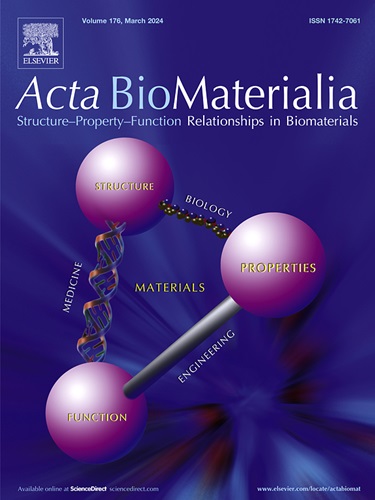将过氧化物酶样掺铜碳点嵌入水凝胶中,用于刺激响应式细菌生物膜消除和伤口愈合。
IF 9.6
1区 医学
Q1 ENGINEERING, BIOMEDICAL
引用次数: 0
摘要
细菌生物膜及其微环境是抗菌药物设计中必须面对的重大挑战。微环境响应型模拟过氧化物酶(POD)已被证明是一种消除细菌生物膜的有效方法。然而,由于对生物膜的渗透性差,它们不可避免地需要额外的H2O2和/或酸。在此,我们报道了一种简单的微波辅助碳化方法合成了类pod的铜掺杂碳点(CuCD1)。超小尺寸(< 5 nm)和带正电荷的特性使其对细菌生物膜具有良好的穿透性。不出所料,CuCD1在弱酸性细菌生物膜微环境下催化分解内源性H2O2产生羟基自由基(•OH),对细菌产生极大的伤害。这种高度增加的氧化应激导致细胞膜通透性的改变,随后的细胞死亡,并最终消灭细菌生物膜碎片和暴露的细菌。此外,为了验证CuCD1在体内的实用性,我们将CuCD1引入到由羧甲基壳聚糖(CMCS)和氧化葡聚糖(ODEX)交联的常规水凝胶中。与对照组相比,CuCD1-CMCS-ODEX复合水凝胶具有更好的抗菌性能,从而加速了伤口愈合和胶原蛋白的配置。这项工作将为设计基于cd的生物膜微环境响应型抗菌纳米剂提供机会。意义说明:(1)设计了超小尺寸,带正电荷,过氧化物酶(POD)样的CuCD1,并通过简单的微波辅助碳化法收获。(2) CuCD1具有较强的体外抗菌性能、良好的穿透性和对细菌生物膜的微环境响应性清除能力。(3)与CMCS-ODEX水凝胶复合后,复合水凝胶能持续清除细菌,促进伤口愈合,并促进胶原蛋白的配置。(4)本研究为基于cds的生物膜微环境响应型纳米抗菌药物的设计提供了新的思路。本文章由计算机程序翻译,如有差异,请以英文原文为准。

Peroxidase-like copper-doped carbon-dots embedded in hydrogels for stimuli-responsive bacterial biofilm elimination and wound healing
Bacterial biofilms and their microenvironment are significant challenges that must be faced in the design of antibacterial drugs. Microenvironment-responsive mimetic peroxidases (POD) have been demonstrated to be an efficient solution to eliminating bacterial biofilms. However, they inevitably require additional H2O2 and/or acid due to the poor permeabilities towards biofilms. Herein, we report POD-like copper-doped carbon dots (named CuCD1) synthesized through a facile microwave-assisted carbonization manner. The characteristics of ultrasmall size (< 5 nm) and positive charge enabled it to possess good penetrability toward bacterial biofilm. As expected, CuCD1 showed great damage to bacteria due to the generation of hydroxyl radicals (•OH), which originated from the catalytic decomposition of endogenous H2O2 under a weak acid bacterial biofilm microenvironment. This highly increased oxidative stress resulted in the alteration of cell membrane permeability, subsequent cell death, and the final eradication of bacterial biofilm and the exposed bacteria. Moreover, to verify the practicality in vivo, CuCD1 was introduced to a routine hydrogel that was crosslinked by carboxymethyl chitosan (CMCS) and oxidized dextran (ODEX). In comparison with the control groups, the composite hydrogel, i.e., CuCD1-CMCS-ODEX revealed better antibacterial performance and thus accelerated wound healing and collagen disposition. This work would open opportunities to design CDs-based biofilm microenvironment-responsive antibacterial nanoagents.
Statement of significance
(1) Ultrasmall size, positively charged, peroxidase (POD)-like CuCD1 were designed and harvested by a facile microwave-assisted carbonization method. (2) CuCD1 revealed a competitive in vitro antibacterial performance, good penetrability, and microenvironment-responsive clearing capacity towards bacterial biofilm. (3) By composing with CMCS-ODEX hydrogel, the composite hydrogel could continuously eliminate bacteria, promote wound healing, as well as collagen disposition. (4) This work would provide a new strategy in the design of CDs-based biofilm microenvironment-responsive antibacterial nano-agents.
求助全文
通过发布文献求助,成功后即可免费获取论文全文。
去求助
来源期刊

Acta Biomaterialia
工程技术-材料科学:生物材料
CiteScore
16.80
自引率
3.10%
发文量
776
审稿时长
30 days
期刊介绍:
Acta Biomaterialia is a monthly peer-reviewed scientific journal published by Elsevier. The journal was established in January 2005. The editor-in-chief is W.R. Wagner (University of Pittsburgh). The journal covers research in biomaterials science, including the interrelationship of biomaterial structure and function from macroscale to nanoscale. Topical coverage includes biomedical and biocompatible materials.
 求助内容:
求助内容: 应助结果提醒方式:
应助结果提醒方式:


